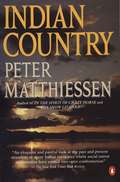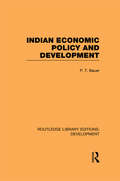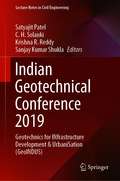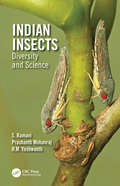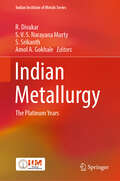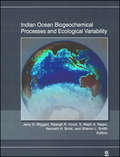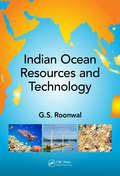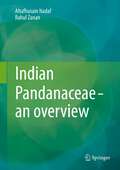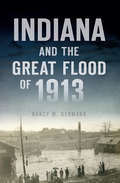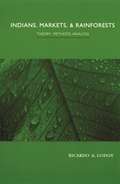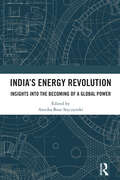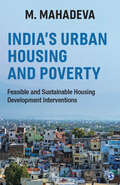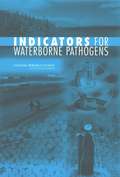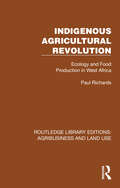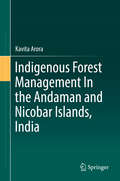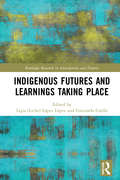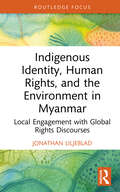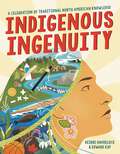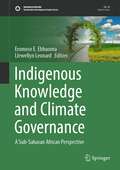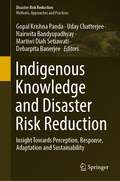- Table View
- List View
Indian Country
by Peter MatthiessenAfter winning an eight year legal battle, here is the controversial book that powerfully sheds new light on the plight of Native Americans. Matthiessen's urgent accounts and absorbing journalistic details make it impossible to ignore the message they so eloquently proclaim.
Indian Economic Policy and Development (Routledge Library Editions: Development)
by P. T. BauerProfessor Bauer’s book, first published in 1961, reviews the major elements of contemporary official Indian development policy, considers their economic implications and their probable political and economic results. He then examines alternative approaches to the promotion of development. The development plans, notably the Second Five Year Plan and the official outlines of the Third Plan, receive major attention, but the author also considers other official policies and measures affecting economic development, which do not usually figure prominently in the formal development plans. Specific themes which Professor Bauer considers are: the influence of social customs and attitudes on economic progress; the relationship between investment expenditure and economic development; inter-relationships between agriculture and industry; the heavy industry programme; the controls over the private section; the relation of Plan finance to the foreign exchange crisis; the role of foreign aid; and the importance of certain major political objectives.
Indian Geotechnical Conference 2019: Geotechnics for INfrastructure Development & UrbaniSation (GeoINDUS) (Lecture Notes in Civil Engineering #140)
by Sanjay Kumar Shukla Krishna R. Reddy C. H. Solanki Satyajit PatelThis book comprises select proceedings of the annual conference of the Indian Geotechnical Society. The conference brings together research and case histories on various aspects of geotechnical and geoenvironmental engineering. The book presents papers on geotechnical applications and case histories, covering topics such as (i) Characterization of Geomaterials and Physical Modelling; (ii) Foundations and Deep Excavations; (iii) Soil Stabilization and Ground Improvement; (iv) Geoenvironmental Engineering and Waste Material Utilization; (v) Soil Dynamics and Earthquake Geotechnical Engineering; (vi) Earth Retaining Structures, Dams and Embankments; (vii) Slope Stability and Landslides; (viii) Transportation Geotechnics; (ix) Geosynthetics Applications; (x) Computational, Analytical and Numerical Modelling; (xi) Rock Engineering, Tunnelling and Underground Constructions; (xii) Forensic Geotechnical Engineering and Case Studies; and (xiii) Others Topics: Behaviour of Unsaturated Soils, Offshore and Marine Geotechnics, Remote Sensing and GIS, Field Investigations, Instrumentation and Monitoring, Retrofitting of Geotechnical Structures, Reliability in Geotechnical Engineering, Geotechnical Education, Codes and Standards, and other relevant topics. The contents of this book are of interest to researchers and practicing engineers alike.
Indian Hotspots: Vertebrate Faunal Diversity, Conservation And Management Volume 2
by Chandrakasan Sivaperuman Krishnamoorthy VenkataramanThis book offers a comprehensive account of India’s four biodiversity hotspots: the Himalaya, Indo-Burma, Western Ghats and Sri Lanka and Andaman and Nicobar Islands. With a focus on tropical rainforests, it includes more than 30 chapters covering different vertebrate fauna e.g. fishes, amphibians, reptiles, birds, and mammals, as well as topics such as conservation and management aspects.Written by experts in the field of biodiversity conservation and management, it offers ample new insights into a number of subjects related to the faunal communities of tropical forest ecosystems, providing a valuable resource for conservationists and researchers in the field of flora and fauna diversity.
Indian Insects: Diversity and Science
by S. Ramani Prashanth Mohanraj Yeshwanth HmInsects are the most interesting and diverse group of organisms on earth, many of which are useful as pollinators of crops and wild plants while others are useful as natural enemies keeping pestiferous insects in check. It is important to conserve these insects for our survival and for this the diversity of insect species inhabiting the different ecosystems of our country must be known. The cornerstone to studies of any kind of organismal diversity is their taxonomic identity. Even after over two and half centuries of studies, so little is known of the insect wealth of our country. It has contributions from taxonomists who have been studying Indian insects for long, this book offers up to date information on many important groups of Indian insects seeking to fill the lacuna of a long felt need for a comprehensive work on the taxonomy of Indian insects. Salient features: Provides an up-to-date taxonomy of major insect groups of India Presents identification keys with illustrations of several important groups of Indian insects Gives a new insight into why insects are so abundant Addresses fundamental questions in mechanoreception and cross kingdom interactions using insects as model systems Indian Insects: Diversity and Science is a festschrift to Professor C. A. Viraktamath, an insect taxonomist par excellence. It has been designed to cater to the needs of academicians, researchers and students who wish to identify insects collected from local environments and will be an invaluable aid for those working in the areas of systematics, ecology, behaviour, diversity and the conservation of insects.
Indian Metallurgy: The Platinum Years (Indian Institute of Metals Series)
by Amol A. Gokhale R. Divakar S. V. S. Narayana Murty S. SrikanthThe book marks the Platinum Jubilee of the Indian Institute of Metals, closely matching independent India's age. It is envisaged as a compilation of technical articles tracing the birth and growth trajectory of metallurgical science, engineering and technology in the nation, attempting a degree of prognostication covering the next quarter of a century. It contains the essence of the metallurgical research and development and industrial progress India has witnessed in the last 75 years. This book comprises technical articles written by industry leaders and eminent technocrats. It includes overviews by distinguished researchers who have strived to build foundations of new metallurgical research and engineering fields. It includes learned writings of persons associated with premier institutions heavily dependent on metallurgy and materials. They have made seminal contributions by nurturing the growth of metallurgical research and industrial production or have made first-hand contributions to building the great organisations we have today. Coinciding with the Platinum Jubilee year of the Indian Institute of Metals, this book brings out the enormous efforts of these individuals representing their organisations to share insights that led to their success as an entity. Similarly, several professionals who significantly contributed to the understanding of metallurgical engineering, have held important positions and steered the national strategic programmes or academically nurtured students in their illustrious careers also share their journey in this book. This book chronicles the significant advances made in the field of metallurgical science, engineering and technology in India, presenting the historical perspective and prospects in the format of a technical volume.
Indian Ocean Biogeochemical Processes and Ecological Variability
by Kenneth H. Brink S. Wajih Naqvi Jerry D. Wiggert Sharon L. Smith Raleigh R. HoodPublished by the American Geophysical Union as part of the Geophysical Monograph Series, Volume 185.Indian Ocean Biogeochemical Processes and Ecological Variability provides a synthesis of current knowledge on Indian Ocean biogeochemistry and ecology and an introduction to new concepts and topical paradigm challenges. It also reports on the development of more extensive/frequent observational capacity being deployed in the Indian Ocean. This represents the first collection of syntheses that emphasize a basin-wide perspective, and the contributing authors include some of the most esteemed oceanographers and Indian Ocean experts in the world. The volume is derived from invited plenary talks that were presented at the initial Sustained Indian Ocean Biogeochemistry and Ecosystem Research (SIBER) workshop held at the National Institute of Oceanography (NIO) in Goa, India, in October 2006.The volume discussesThe overlying physical processes set by monsoonal forcing and how these control biological production and variabilityNutrient cycling and limitationPelagic carbon cycling and air-sea exchangeBenthic biogeochemistry and ecologyThe impact of climate and human activities on biogeochemistry and ecosystems.The readership for this book will consist of academic and governmental researchers interested in exploring how oceanographic, atmospheric, and hydrological processes combine to establish the environmental setting that supports and drives the pelagic system and which are especially relevant to understanding the complex biogeochemical and ecological interactions in the Indian Ocean.
Indian Ocean Resources and Technology
by Ganpat Singh RoonwalThe current scenario provides an ideal opportunity to confer higher priority to the marine resources of the Indian Ocean, particularly in terms of integrated management of the deep sea, shallow sea and coastal resources. This will maximize their potential in the sustainable development goal (SDG) pattern, leading to an appropriate environmental management. Therefore, this book aims to provide an overview of the area and to highlight the potential market opportunities represented by this vast and rapidly developing nation. In doing so the following aspects have been covered: Exclusive title focussing on mineral resources of Indian ocean. Discusses living, nonliving, ocean waves and tidal energy, ocean environment and protection aspects. Includes information on key themes, details of organizations associated with the Indian Ocean. Illustrates deep sea mining technology and environmental perspectives. Covers hydrocarbons-sub sea oil and gas, minerals from placer deposits to deep sea nodules, sea floor massive sulphides and cobalt rich encrustations.
Indian Ocean Tropical Cyclones and Climate Change
by Yassine CharabiThe book is about climate change and tropical cyclones, with an emphasis on the Indian Ocean. It highlights a probability of major changes in tropical cyclone activity across the various ocean basins. The Indian Ocean including the Arabian Sea and the Bay of Bengal are of particular concern because of the high population density along their coastlines. The book aims to reveal the scientific bases of the extreme events and the complexities inherent in combating their hazardous impact. The chapters are authored by leading experts, both from research and operational meteorological environments. The book is intended to be a first step towards an ongoing international focus on potential impact of climate change in the Indian Ocean. Topics are related to current status of operational tropical cyclone forecasting and early warning systems, tropical cyclone genesis, assessment of risk and vulnerability from tropical cyclones and disaster preparedness, management and reduction.
Indian Pandanaceae - an overview
by Altafhusain Nadaf Rahul ZananIndian screw pine family Pandanaceae represents three genera, in which genus Pandanus and Benstonea are distributed in two hotspots in India - the Western Ghats and the Northeast Himalayan region. For the first time, Indian Pandanaceae has been assessed for its taxonomic status and phylogenetic relationship. The extensive survey by the authors led to the discovery of three new Pandanus species (two from the Western Ghats and one from the Northeast Himalaya). The present taxonomic revision confirmed total number of Pandanus species to 14 that are distributed in the Southern India (9 species) and Northeast Himalayan region (5 species). Genus Benstonea is represented by two species, one from Southern India and another species common to both regions. A detailed species identification key is given along with conservation status of each species following IUCN Red List Categories and Criteria (2001). The study revealed that, out of 16 Pandanus and Benstonea species, six species are under threatened categories. In recent years, a chloroplast DNA-based molecular phylogenetic approach has been followed to understand the evolutionary relationship among the plant species. The interrelationship among the 14 Pandanus species at infrageneric level has been worked out using this approach, which has led to the rearrangement of some species to the subgenera proposed by Stone (1974). Moreover, the close relationship between Pandanus and Benstonea has been confirmed and the interrelationship of Indian Pandanus genus in global context is given. This book also describes the economic importance of each Pandanus species.
Indiana and the Great Flood of 1913 (Disaster)
by Nancy M. GermanoIndiana suffered enormous losses in the Great Flood of 1913, yet this disaster is largely forgotten. The combined tornado and flood barreled through Terre Haute, killing more than twenty. In Peru, 114 miles away, the circus lost most of its animals in the storm. At the southwestern corner of the state, a "sea of water," as local papers put it, washed over Evansville, turning streets into canals. In the capital, levee failures left hundreds homeless and vulnerable to disease and famine. Pulling from archival photographs, newspapers and local accounts, Dr. Nancy M. Germano shares stories from across the state to reveal how Indiana's history of settlement and development contributed to one of the state's worst disasters.
Indians, Markets, and Rainforests: Theoretical, Comparative, and Quantitative Explorations in the Neotropics
by Ricardo GodoyGodoy investigates five lowland Amerindian societies of tropical Latin America--all of which are experiencing deep changes as they modernize--to discover the results of a market economy on both indigenous peoples and the conservation of tropical rainforest flora and fauna.
Indians, Markets, and Rainforests: Theoretical, Comparative, and Quantitative Explorations in the Neotropics
by Ricardo GodoyThis book addresses two important and related questions: does participation in a market economy help or hurt indigenous peoples and how does it affect the conservation of tropical rainforest flora and fauna? Oddly, there have been few quantitative studies that have addressed these issues.Ricardo Godoy's research takes an important step toward rectifying this oversight by investigating five different lowland Amerindian societies of tropical Latin America—all of which are experiencing deep changes as they modernize. Godoy examines the effect of markets on a broad range of areas including health, conservation of flora and fauna, leisure, folk knowledge, reciprocity, and private time preference. He concludes that, contrary to considerable anthropological theory, the effect of markets on the quality of life and the rainforest are often unclear or benign. Godoy uses multivariate techniques to examine the changes modernization has had on many indicators of the quality of life and the environment and concludes that the seeds of socioeconomic differentiation may already lie dormant in simple economies.The impact of modernization on lowland Amerindians is a topic of great concern to anthropologists, researchers, and policymakers in developing nations, and this book is a significant contribution to the debate about the likely future of indigenous people.
India’s Energy Revolution: Insights into the Becoming of a Global Power
by Annika Bose StyczynskiIndia is the third-largest emitter of greenhouse gases, which makes it an important player whose climate mitigation actions and inactions are closely scrutinised. This book studies developments in India’s energy system from a governance perspective. It presents a unique compilation and synthesis of research findings that capture achievements, shortcomings, and persistent and transient challenges of India’s transition towards a net-zero economy by 2070.The book grounds its analysis in domestically formulated goals and reflects on dynamics at the structural level of India’s multi-scalar innovation system, by highlighting the influencing factors of energy system status and change. It presents the perspectives and positions of different actor groups, studies the market and business, and discusses cases influenced by existing or changing institutions across the whole spectrum of energy resources from fossil to non-fossil fuels and respective technologies.The volume will be useful for students and researchers in energy governance, energy policy and economics, socio-technical transition studies, energy systems engineering, sustainable development, and environmental studies. It will also be of interest to policymakers and investors.
India’s Urban Housing and Poverty: Feasible and Sustainable Housing Development Interventions
by M. MahadevaIndia is undoubtedly urbanizing, especially since 1991. But many urban families have been facing housing poverty and struggling to access safe drinking water, electricity, sanitation and other basic amenities. India’s Urban Housing and Poverty: Feasible and Sustainable Housing Development Interventions covers the overall situation of the urban settlements, institutional players and public policy changes with a focus on human settlement issues and the problem of a consistently degrading environment. It makes extensive use of relevant data on the concerned issues and analyzes the core issues at macro level. It covers the history of housing development policies and policies for the urban poor since the 1950s. The book offers recommendations for sustainable and equitable urban growth. It discusses institutional growth in the housing sector, operations in response to the housing needs, development governance and so on. Equal importance for redevelopment of dilapidated stock and development of new housing units, new efforts towards slum improvement, rejuvenating the cooperative housing movement are some of the strategies proposed and discussed extensively.
Indicators For Waterborne Pathogens
by National Research Council of the National AcademiesRecent and forecasted advances in microbiology, molecular biology, and analytical chemistry have made it timely to reassess the current paradigm of relying predominantly or exclusively on traditional bacterial indicators for all types of waterborne pathogens. Nonetheless, indicator approaches will still be required for the foreseeable future because it is not practical or feasible to monitor for the complete spectrum of microorganisms that may occur in water, and many known pathogens are difficult to detect directly and reliably in water samples. This comprehensive report recommends the development and use of a “tool box” approach by the U. S Environmental Protection Agency and others for assessing microbial water quality in which available indicator organisms (and/or pathogens in some cases) and detection method(s) are matched to the requirements of a particular application. The report further recommends the use of a phased, three-level monitoring framework to support the selection of indicators and indicator approaches.
Indicators for Urban and Regional Planning: The Interplay of Policy and Methods (RTPI Library Series)
by Cecilia WongThis book focuses on the measurement and utilisation of quantitative indicators in the urban and regional planning fields. There has been a resurgence of academic and policy interest in using indicators to inform planning, partly in response to the current government's information intensive approach to decision-making. The content of the book falls into three broad sections: indicators usage and policy-making; methodological and conception issues; and case studies of policy indicators.
Indigenous Agricultural Revolution: Ecology and Food Production in West Africa (Routledge Library Editions: Agribusiness and Land Use #21)
by Paul RichardsOriginally published in 1985, this book argues forcefully and practically for new relationship between science and the small farmer. It advocates scientific research seeking out changes which are already taking place within the smallholder farming sector and building on local initiatives. Drawing on his experience of West Africa, the author demonstrates that many of the most successful innovations in food-crop production during the 20th century have indigenous roots and that there should therefore be less emphasis on ‘teaching’ farmers how to farm and more emphasis on how to foster and support local adaptation and inventiveness. This book will be of interest to students of agriculture, environmental studies and rural development as well as those working with relief and development agencies.
Indigenous Cultures and Sustainable Development in Latin America
by Timothy MacNeillThis open access book outlines development theory and practice overtime as well as critically interrogates the “cultural turn” in development policy in Latin American indigenous communities, specifically, in Guatemala, Honduras, Ecuador, and Bolivia. It becomes apparent that culturally sustainable development is both a new and old idea, which is simultaneously traditional and modern, and that it is a necessary iteration in thinking on development. This new strain of thought could inform not only the work of development practitioners, graduate students, and theorists working in the Global South, but in the Global North as well.
Indigenous Forest Management In the Andaman and Nicobar Islands, India
by Kavita AroraThis book offers an extensive study of indigenous communities in the Andaman and Nicobar Islands, India, and their methods of forest conservation, along with an exploration of the impact of forestry operations in the islands and the wide scale damage they have incurred on both the land and the people. Through an in-depth analysis of the contrasting indigenous practices and governmental forestry schemes, the author has compared the modern ‘Joint Forest Management’ resolution with the ethos and practices of the indigenous people of the Andaman and Nicobar Islands. Throughout the book, readers will learn about the different indigenous communities inhabiting these islands and the treasure of knowledge each of them provide on forest conservation. The book establishes that the notion of knowledge is politicized by the dominant culture in the context of Andaman’s forest tribes, and traces how this denial of the existence of indigenous knowledge by government officials has led to reduced forest area in the region. The book also explores and analyses strategies to utilize and conserve the tribes' profound knowledge of the biodiversity of the islands and study their efforts towards forest conservation, protection and rejuvenation.
Indigenous Futures and Learnings Taking Place (Routledge Research in Anticipation and Futures)
by Ligia López LópezSingularizing progressive time binds pasts, presents, and futures to cause-effect chains overdetermining existence in education and social life more broadly. Indigenous Futures and Learnings Taking Place disrupts the common sense of "futures" in education or "knowledge for the future" by examining the multiplicity of possible destinies in coexistent experiences of living and learning. Taking place is the intention this book has to embody and world multiplicity across the landscapes that sustain life. The book contends that Indigenous perspectives open spaces for new forms of sociality and relationships with knowledge, time, and landscapes. Through Goanna walking and caring for Country; conjuring encounters between forests, humans, and the more-than-human; dreams, dream literacies, and planes of existence; the spirit realm taking place; ancestral luchas; Musquem hən̓q̓əmin̓əm̓ Land pedagogies; and resoluteness and gratitude for atunhetsla/the spirit within, the chapters in the collection become politicocultural and (hi)storical statements challenging the singular order of the future towards multiple encounters of all that is to come. In doing so, Indigenous Futures and Learnings Taking Place offers various points of departure to (hi)story educational futures more responsive to the multiplicities of lives in what has not yet become. The contributors in this volume are Indigenous women, women of Indigenous backgrounds, Black, Red, and Brown women, and women whose scholarship is committed to Indigenous matters across spaces and times. Their work in the chapters often defies prescriptions of academic conventions, and at times occupies them to enunciate ontologies of the not yet. As people historically fabricated "women," their scholarly production critically intervenes on time to break teleological education that births patriarchal-ized and master-ized forms of living. What emerges are presences that undiscipline education and educationalized social life breaking futures out of time. This book will be of great interest to students and scholars of Indigenous studies, future studies, post-colonial studies in education, settler colonialism and coloniality, diversity and multiculturalism in education, and international comparative education.
Indigenous Identity, Human Rights, and the Environment in Myanmar: Local Engagement with Global Rights Discourses (Routledge Focus on Environment and Sustainability)
by Jonathan LiljebladThis book draws on the experiences of the indigenous movement in Myanmar to explore how the local construction of indigenous identities connects communities to global mechanisms for addressing human rights and environmental issues. Various communities in Myanmar have increasingly adapted international discourses of indigenous identity as a vehicle to access international legal mechanisms to address their human rights and environmental grievances against the Myanmar state. Such exercise of global discourses overlays historical endemic struggles of diverse peoples involving intersectional issues of self- determination, cultural survival, and control over natural resources. This book draws implications for the intersectionality of local and global theoretical discourses of indigeneity, human rights, and environment. It uses such implications to identify attendant issues for the aspirations of international human rights and environmental efforts and the practice of their associated international legal mechanisms. This book informs readers of the agency and capabilities of communities in underdeveloped countries to engage different global mechanisms to address local grievances against their states. Readers will develop a more critical understanding of the issues posed by the local construction of indigeneity for the ideals and practice of international efforts regarding human rights and the environment. This book will be of great interest to students and scholars of indigenous studies, human rights, international law, Asian studies, development studies, and the environment.
Indigenous Ingenuity: A Celebration of Traditional North American Knowledge
by Edward Kay Deidre HavrelockCelebrate Indigenous thinkers and inventions with this beautifully designed, award-winning interactive nonfiction book—perfect for fans of Braiding Sweetgrass. <P><P>Corn. Chocolate. Fishing hooks. Boats that float. Insulated double-walled construction. Recorded history and folklore. Life-saving disinfectant. Forest fire management. Our lives would be unrecognizable without these, and countless other, scientific discoveries and technological inventions from Indigenous North Americans. Spanning topics from transportation to civil engineering, hunting technologies, astronomy, brain surgery, architecture, and agriculture, Indigenous Ingenuity is a wide-ranging STEM offering that answers the call for Indigenous nonfiction by reappropriating hidden history. <P><P>The book includes fun, simple activities and experiments that kids can do to better understand and enjoy the principles used by Indigenous inventors. Readers of all ages are invited to celebrate traditional North American Indigenous innovation, and to embrace the mindset of reciprocity, environmental responsibility, and the interconnectedness of all life.
Indigenous Knowledge and Climate Governance: A Sub-Saharan African Perspective (Sustainable Development Goals Series)
by Llewellyn Leonard Eromose E. EbhuomaThis book investigates indigenous knowledge systems (IKS) in sub-Saharan Africa, thereby highlighting its role in facilitating adaptation to climate variability and change, and also demystifying the challenges that prevent it from being integrated with scientific knowledge in climate governance schemes. Indigenous people and their priceless knowledge rarely feature when decision-makers prepare for future climate change. This book showcases how Indigenous knowledge facilitates adaptation to climate change, including how collaborations with scientific knowledge have cascaded into building people’s resilience to climatic risks. This book also pays delicate attention to the factors fueling epistemic injustice towards Indigenous knowledge, which hampers it from featuring in climate governance schemes across sub-Saharan Africa. The key insights shared in this book illuminate the issues that contribute meaningfully towards the actualisation of the UN SDG 13 and promote mechanisms for raising capacity for effective climate change-related planning and management in sub-Saharan Africa.
Indigenous Knowledge and Disaster Risk Reduction: Insight Towards Perception, Response, Adaptation and Sustainability (Disaster Risk Reduction)
by Uday Chatterjee Nairwita Bandyopadhyay Martiwi Diah Setiawati Gopal Krishna Panda Debarpita BanerjeeThe book seeks to comprehend how indigenous knowledge systems of local communities can be effectively used in disaster management of various types. A prime example is the 2015 Sendai Framework for Disaster Risk Reduction, promoting indigenous environmental management knowledge and practices. Traditional knowledge of indigenous peoples includes information and insight that supplement conventional science and environmental observations, a comprehensive understanding of the environment, natural resources, culture, and human interactions with them which is not documented before. A great deal of this knowledge have been lost in translation. In this book, the authors attempt to keep a record of each and every traditional knowledge study of the indigenous communities in managing the disasters. The use of indigenous knowledge systems in disaster understanding and management is the primary focus of the chapters. This book is organized into four major sections. The first part gives an overview and help in conceptualizing the different concepts of hazard and disaster perception and how response and adaptation are connected with it. This part also discusses the concept of the connection between hazard and sustainable development and how the understanding of risk reduction and resilience can happen with the help of indigenous knowledge, insights, and strategies. The second part of the book introduces the different approaches to disaster and risk management. It establishes how vulnerability influences the risk associated with a hazard and the responses can be both positive and negative in disaster management. The approaches of the indigenous communities in managing a disaster, their resilience, capacity building, and community-based preparedness will be the area of prime focus in this chapter. Part 3 of this book describes the concept of sustainability through indigenous knowledge and practice. The sole highlight of this chapter is the indigenous knowledge efficacies in disaster identification, risk reduction, climate risk management, and climate action. The last section of the book explores how to meet the gaps between local knowledge and policy formulation. It highlights how traditional knowledge of the indigenous communities can prove to be beneficial in developing a holistic regional-based policy framework which will be easily accepted by the target stakeholders since they will be more acquainted with the local strategies and methods. This section ends with an assessment and discussion of the gaps and future scopes in disaster risk reduction through integrating local knowledge and modern technologies.
